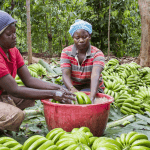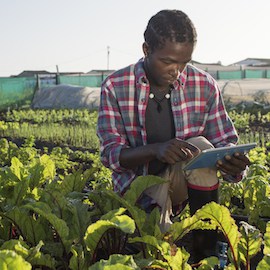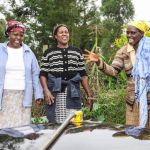Supporting Women Farmers in the Age of Climate Change: Why It’s Time To Look at Agriculture Solutions Through Both a Gender and Climate Lens
In sub-Saharan Africa, women smallholder farmers (relative to their male counterparts) have lower access to productive resources like land, and to educational resources that build technical and digital skills. They are also less likely to own a mobile phone, and they face mobility and time constraints and have lower decision-making power. These barriers in access to resources are driven and worsened by entrenched sociocultural norms and traditional expectations of gender roles. The disproportionate effect of the obstacles facing women farmers results in 20-30% less production from women than men across developing countries.
These systemic challenges are exacerbated by climate change, which is causing additional issues that will likely have a greater impact on women, as they have fewer resources than men, are more vulnerable to climate disaster and have less ability to recover from shocks. For instance, climate change is likely to cause water shortages in water-scarce and marginal areas, with 52% of the world’s population expected to be living in water-stressed regions by 2050. This will increase the burden on women, who will need to spend more time fetching and carrying water from more distant locations (as water collection is a task typically performed by women in emerging markets). Climate change will also have a negative impact on productivity, as the temperature increase reduces yields for key crops. For example, global wheat yields are expected to decline by 6% for every degree of temperature rise, and women have less ability to adapt to these declines.
Due to these and other challenges, by 2050 over 140 million people could become climate migrants in three regions (sub-Saharan Africa, South Asia and Latin America) – many of them forced off marginal agricultural land as a result of changing weather patterns. A majority of these migrants are likely to be women, who are at greater risk during migration and conflict due to the threat of trafficking and exploitation.
The Need for Climate-Adaptive Solutions for Women Farmers
In response to these growing risks, women need support to access climate-adaptive solutions to build their productivity and resilience. These solutions involve technology, regenerative agricultural practices, information and finance, including access to:
- Technologies that sustainably improve productivity – e.g., solar water pumps and soil health testing devices;
- Regenerative practices that rebuild the health of ecosystems, often incorporating a shift to regenerative agriculture – e.g., agroforestry and no-till farming;
- Information that enables better decision-making amid a changing climate – e.g., weather information and forecasting that informs changes to planting zones; and
- Finance that helps farmers to invest and adapt to the changing climate – e.g., by enabling access to the technologies, practices and information described above.
However, women face challenges in accessing climate solutions due to their lack of decision-making power over agricultural practices, their lack of access to and control over resources, and the time burdens and mobility limitations they experience. We’ll explore these issues in more detail below.
Decision-making power: As men are typically the primary decision makers, women farmers are excluded from the uptake of beneficial agricultural practices, such as changing the type of crops planted or fertilizers used, and as a result are slower in the uptake of climate-positive practices.
Access to and control of resources: Women face barriers to their access to and control of financial resources, productive assets and knowledge, all of which limit their ability to adopt climate-positive farming practices. The consequences of these barriers include:
- Financial resources: Women farmers have less access to and control over finances, limiting their ability to purchase the necessary inputs and technologies to adapt to climate change. Climate-smart technologies can be more expensive than alternatives and harder for women to finance – for example, a solar water pump is more expensive upfront than a diesel pump, although the running cost of diesel makes it more expensive in the long run.
- Productive assets: Women smallholder farmers have lower access to productive assets such as land, machinery and irrigation services. These assets help determine agricultural productivity and livelihoods, so this lack of access limits women’s ability to use climate-smart farming practices – e.g., planting drought-tolerant varieties of crops. This issue is driven by women’s lower incomes, and by sociocultural norms that often deem mechanisation as a man’s domain. For example, women farmers in Kenya own 18% less agricultural tools and equipment than men farmers.
- Knowledge: In most sub-Saharan African countries, women farmers have lower literacy levels than men, especially in digital literacy. In developing countries globally, women are 1.6 times more likely to report a lack of skills for internet use, and they tend to have less formal training in ICT skills compared to men, limiting their use of digital agricultural products. This restricts their ability to learn and adopt new skills crucial to implementing regenerative agricultural practices, and to build livelihoods through online resources such as e-learning platforms
Time burdens and mobility limitations: Compared to men farmers, women smallholders face additional time burdens due to the unequal distribution of childcare and household responsibilities. They also face mobility challenges due to numerous barriers, including lower incomes and time poverty. Consequently, they have both less time and less money available to engage in activities like the usage of learning products that can support climate-positive agricultural practices.
Combining a Gender and Climate Lens to Support Women Farmers
In addressing these challenges, combining a gender and a climate lens can have catalytic impacts in supporting climate-smart practices in agriculture. Gender-transformative approaches are designed to reduce women’s barriers in agency and control over resources, aiming to tackle the root causes of these issues and create sustainable impact. Targeting women farmers intentionally to correct inequalities means developing an understanding of how these women are affected by climate change, and then supporting them in the ways that are most suited to their needs.
That support can involve increasing women’s access to new agricultural technologies and practices. For example:
- Solar water pumps can reduce the need for women to collect water, giving them time to spend on other tasks related to navigating the challenges of climate change.
- Similarly, no-till agriculture practices remove the need to till the fields, replacing an arduous and time-consuming manual task with a simple process of hole-drilling for seeds.
- Intercropping practices – i.e., growing more than one crop on the same land – can help to diversify income and thereby reduce risk for the farmer, providing a more stable income over the season.
Further, climate-positive technologies that boost yields can have a larger proportional effect on women, given their lower productivity levels to start with. When women have equal productive resources to men, their yields increase by up to 30%. Interventions focused on climate information can also have an impact, providing women with the means to make better-informed decisions about their farm – especially when they’re coupled with inclusive dialogue and efforts to obtain men’s buy-in for building women’s agency. And finally, access to finance – both targeted at climate adaptation, but also more broadly – can help to give women more control and agency over their lives, building their resilience and enabling them to cope with future climate-related shocks, such as failed harvests.
Designing an Agricultural Support Strategy Around Climate and Gender
Ensuring that both climate and gender are part of their vision of agricultural support can help organisations to embed these considerations upfront in strategy design and the creation of products. This can also help them avoid perpetuating unsustainable climate practices and damaging gender norms. To that end, organisations working with smallholder farmers can choose to align their efforts with environmentally minded partners, working together to maintain gender intentionality. Working with those who share and promote climate and gender goals can ensure that these dual ambitions are embedded throughout implementation. Below, we’ll discuss three elements of this combined approach: targeting women’s participation, engaging men and boys, and collecting data.
Targeting the participation of women in agricultural decision-making can increase the uptake of climate-smart practices. A study by Climate Change, Agriculture and Food Security found that women in Kenya’s Nyando district who had more decision-making power were more likely to adopt climate-positive practices. Among participants in that study, the quickest adoption of drought-resistant crops was by women whose husbands were away, allowing these women to make the day-to-day decisions for the farm. Other studies have found that women are also more likely to use their agency to support sustainable and regenerative action in agriculture, as they are more likely to make decisions based on the long-term needs of the farm.
Engaging men, boys and other family members as part of transformative agricultural approaches will increase women’s ability to make the decision to adopt climate-positive farming practices. This may involve engaging the spouses and parents of women farmers, who are often the gatekeepers that can increase women’s agency in household-level decision-making. For example, in its work with households in Tanzania that included both women and men, the humanitarian organisation CARE found that the men saw immediate benefits in their households when their wives increased their participation in financial decision-making. These women often used their earned money to support their children’s education and improve the quality of their homes, and also to become less dependent on their husbands’ income. This made men more accepting of women’s participation in activities outside of the home. This same dynamic can be applied to climate solutions: If women were to adopt climate-smart solutions and see results, in the form of increasing yields and resilience, that have economic benefits for the household, men would see the benefits of women’s participation and independent decision-making.
Collecting data on the impact of environmental factors on women farmers can help organisations and advocates to better understand both the challenges faced by these women and the accelerating effects of the climate crisis. Gathering data on environmental factors such as soil carbon, crop cover and weather patterns can lead to a greater understanding of the changing environment, generating solutions that will enable better agricultural planning. Field data is essential in building environmental understanding – coupling this data with sex-disaggregated data will help sector stakeholders to understand and demonstrate how women are impacted more heavily by the climate crisis, and where they need support. However, it is important to also recognise that women do not represent a homogenous group, and that different groups of women may have different challenges and needs. Recognising which women can act as climate champions in their communities will help organisations to target gender-transformative approaches and accelerate climate action.
Agriculture solutions that do not consider climate and gender may not just fail – they may even cause greater inequality and discrimination. Climate-positive interventions that overlook the inclusion of women could help to build only the resilience of men, while leaving women more vulnerable. New technologies and practices could also reduce women’s agency – or even replace the roles traditionally held by women farmers, thereby reducing their income and ownership. For example, some women have resisted adopting practices like intercropping for crops that are traditionally seen as “women’s crops,” due to fears that they will lose control over farming decisions that were previously theirs to make. Taking a human-centred design approach can help to build the perspectives and power of women into the design of programmes, leading to stronger gender outcomes as well as greater environmental benefits.
In short, developing climate strategies in agriculture without considering women will omit some of the greatest potential agents for change. Similarly, developing a gender strategy in agriculture without including climate considerations will leave out potential solutions that could drive sustainable impact for women. Adopting a gender and climate lens is not always simple, but addressing these challenges together can go a long way toward solving some of the core systemic challenges in global development.
Bianca Samson is a Project Manager, Flavia Howard is a Climate & Environment Practice Manager, and Charlie Habershon is an Associate Partner at Dalberg Advisors.
Photo courtesy of UN Women/Ryan Brown.
- Categories
- Agriculture, Environment



